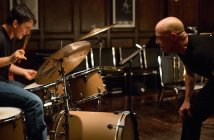Editor’s Notes: The following capsule reviews are part of our coverage of the 2014 Vancouver International Film Festival. For more information on the festival visit viff.org and follow VIFF on Twitter at @viffest.
Leviathan
Dir. Andrey Zvyagintsev
As a grand, unequalled presence, Leviathan refers to the invisible forces that govern the moral and social world: religious and political bodies. Visual metaphors are presented in large expanses of water, a giant skeleton, and a bulldozer. These symbols display a contrast of sorts: they are natural and mechanical; their great presence is visible. The great forces, however, behind bodies of religion and politics remain unseen. The contradiction between natural (visible) and social (invisible) forces symbolizes a great hypocrisy. In Leviathan, a family in crisis deals with this hypocrisy as it affects, dominates, and thus governs social well-being.
A high concept Russian film, Leviathan presents hypocrisy in government and law, bodies which are dependent on man’s intent and are thus corruptible. Zvyagintsev masterfully creates a visual language to support this. The film incorporates two long tracking shots, one near the beginning and one near the end, one wherein the camera tracks towards a governmental body and one wherein the camera tracks towards a religious body. The parallel between judge and father as archetypal symbols of leviathan—of invisible but inescapable force—is thus visually diagnosed through symmetry; it’s a pattern. Book ending the film with these two shots presents a visual metaphor of leviathan on equal ends, fully encapsulating all action and all livelihood. It is invisible and inescapable and surrounds us in every direction.
The Price We Pay
Dir. Harold Crooks
A documentary in Cinema Verité form, The Price We Pay brings to attention the tax evasion and tax havens which receive activity from major corporations and banks. Throughout the film, Crooks examines this phenomenon and aptly considers its affects on the average citizen. As a result, the documentary is not only highly informing but works as a meaningful call to action.
Though The Price We Pay presents many highly informing interviews and court settings, it is flawed in its lack of evidentiary editing. In the documentary mode, it is important to edit in a non-manipulative manner. In this case, Crooks is not trying to be manipulative, but his lack of evidentiary editing sometimes denigrates his point. For example, when discussing the Robin Hood tax, the conversation is cut with meaningless images of Robin Hood. Perhaps it is meant simply to entertain; in any event, it is entirely superficial, as is the architecture shown when discussing Europe.
In spite of this, the sheer resourcefulness of Crooks’ documentary provides a keen understanding of what is happening in the world and how we are to change it. Its leading point, albeit repetitively stated, comments that a general response to activism suggests that global economics, including worldwide communications, is necessary. In other words, taxation needs to be regulated on a global scale, or else off shore tax evasion and city abandonment will continue to happen. With this idea, Crooks doesn’t present an idealism, but an idea which could become actually realized if we all play a part in creating change.
Black Coal, Thin Ice
Dir. Yi’nan Diao
Black Coal, Thin Ice displays an exceptional mise-en-scene involving opaque glass windows, ice, filtered lighting, and smoke. The result is a heavily nuanced, grainy and gritty film quality, aesthetically reminiscent of 1940s film noir. This Chinese neo-noir, however, uses expressionistic tendencies to create mood. This in conjunction with its natural soundtrack of washing machines, ice skates, and weather, Black Coal, Thin Ice conveys a brilliantly involved and affected atmosphere of solemnity and disquietude.
Diao demonstrates a mastery of composition as his incredible use of foreground and background aesthetically enhances the film. There is much on and off screen action, with the camera actively inserting itself into and out of the action. In a gorgeously realized shot of a fire drill, Diao begins at a high angle watching smoke careen the sky. He slowly tilts the camera down to reveal one, two, three coal fires artistically placed within the smoky area. Visually, Black Coal, Thin Ice is mesmerizing. The juxtaposition of smoke and ice—fire and water—constantly creates a sharp, aesthetically impressive, and highly resonating image to complement the shadowy happenings in this dark neo-noir thriller.





